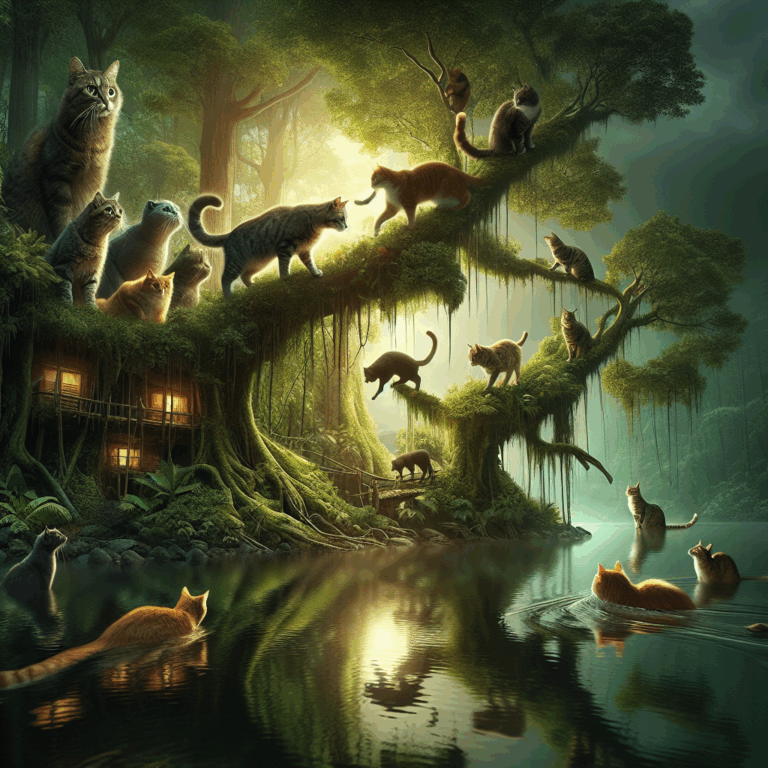The Feline Ecologists: Cats and Their Impact on Biodiversity
- No Comments
In the world of biodiversity, cats play a surprisingly significant role, influencing ecosystems both as cherished pets and as formidable predators. Domestic and feral cats alike have become key players in the intricate web of ecological interactions, prompting scientists and conservationists to pay closer attention to their impact on various species and habitats.
Cats, as natural hunters, have a profound effect on the populations of small mammals, birds, and reptiles. Studies have shown that domestic cats, particularly those allowed to roam outdoors, can have a substantial impact on local wildlife. With their innate hunting skills, cats can reduce the numbers of certain species, sometimes leading to shifts in the balance of local ecosystems. In some areas, this predation pressure has been linked to the decline of native species, raising alarms among conservationists who seek to protect vulnerable wildlife.
However, the ecological role of cats is not solely one of a predator. In several instances, cats have been observed to contribute to the control of pest populations, such as rodents, which can be beneficial in maintaining agricultural productivity and reducing the spread of diseases. This duality makes the relationship between cats and biodiversity a complex and nuanced subject, requiring careful consideration and management strategies.
Recent research has focused on understanding the broader ecological footprint of cats, incorporating both their positive and negative impacts. One area of interest is the behavioral ecology of cats, particularly how their hunting habits and territorial range can influence the species they interact with. Scientists are employing tracking technologies and ecological modeling to gain insights into the movement patterns of cats, both domestic and feral, to better understand their interactions with other wildlife.
In urban settings, where green spaces are limited, cats can become significant players in shaping local biodiversity. Cities often host a mix of wild and domesticated species, creating unique ecosystems where cats can influence the abundance and diversity of other animals. Urban ecologists are particularly interested in how cats might help control certain pest species, while also considering measures to mitigate their impact on native wildlife.
Efforts to manage the ecological impact of cats are varied and often culturally specific. In some regions, initiatives have been launched to promote responsible pet ownership, encouraging cat owners to keep their pets indoors or implement measures like bell collars to reduce hunting success. Meanwhile, feral cat populations are being managed through Trap-Neuter-Return (TNR) programs, which aim to reduce their numbers humanely while minimizing their ecological impact.
The conversation surrounding cats and biodiversity is evolving, with increasing awareness of the delicate balance needed to protect both domestic cats and wildlife. As we continue to explore the role of cats in ecological systems, it becomes clear that they are more than just beloved companions; they are active participants in the ecosystems they inhabit. Understanding their impact is crucial for developing strategies that support both biodiversity conservation and the well-being of cats themselves.
In conclusion, the relationship between cats and biodiversity is a multifaceted one, presenting both challenges and opportunities for ecologists and conservationists. As we strive to preserve the intricate balance of nature, recognizing the influential role of cats in ecosystems is an essential step towards sustainable coexistence.

In the world of biodiversity, cats play a surprisingly significant role, influencing ecosystems both as cherished pets and as formidable predators. Domestic and feral cats alike have become key players in the intricate web of ecological interactions, prompting scientists and conservationists to pay closer attention to their impact on various species and habitats.
Cats, as natural hunters, have a profound effect on the populations of small mammals, birds, and reptiles. Studies have shown that domestic cats, particularly those allowed to roam outdoors, can have a substantial impact on local wildlife. With their innate hunting skills, cats can reduce the numbers of certain species, sometimes leading to shifts in the balance of local ecosystems. In some areas, this predation pressure has been linked to the decline of native species, raising alarms among conservationists who seek to protect vulnerable wildlife.
However, the ecological role of cats is not solely one of a predator. In several instances, cats have been observed to contribute to the control of pest populations, such as rodents, which can be beneficial in maintaining agricultural productivity and reducing the spread of diseases. This duality makes the relationship between cats and biodiversity a complex and nuanced subject, requiring careful consideration and management strategies.
Recent research has focused on understanding the broader ecological footprint of cats, incorporating both their positive and negative impacts. One area of interest is the behavioral ecology of cats, particularly how their hunting habits and territorial range can influence the species they interact with. Scientists are employing tracking technologies and ecological modeling to gain insights into the movement patterns of cats, both domestic and feral, to better understand their interactions with other wildlife.
In urban settings, where green spaces are limited, cats can become significant players in shaping local biodiversity. Cities often host a mix of wild and domesticated species, creating unique ecosystems where cats can influence the abundance and diversity of other animals. Urban ecologists are particularly interested in how cats might help control certain pest species, while also considering measures to mitigate their impact on native wildlife.
Efforts to manage the ecological impact of cats are varied and often culturally specific. In some regions, initiatives have been launched to promote responsible pet ownership, encouraging cat owners to keep their pets indoors or implement measures like bell collars to reduce hunting success. Meanwhile, feral cat populations are being managed through Trap-Neuter-Return (TNR) programs, which aim to reduce their numbers humanely while minimizing their ecological impact.
The conversation surrounding cats and biodiversity is evolving, with increasing awareness of the delicate balance needed to protect both domestic cats and wildlife. As we continue to explore the role of cats in ecological systems, it becomes clear that they are more than just beloved companions; they are active participants in the ecosystems they inhabit. Understanding their impact is crucial for developing strategies that support both biodiversity conservation and the well-being of cats themselves.
In conclusion, the relationship between cats and biodiversity is a multifaceted one, presenting both challenges and opportunities for ecologists and conservationists. As we strive to preserve the intricate balance of nature, recognizing the influential role of cats in ecosystems is an essential step towards sustainable coexistence.


